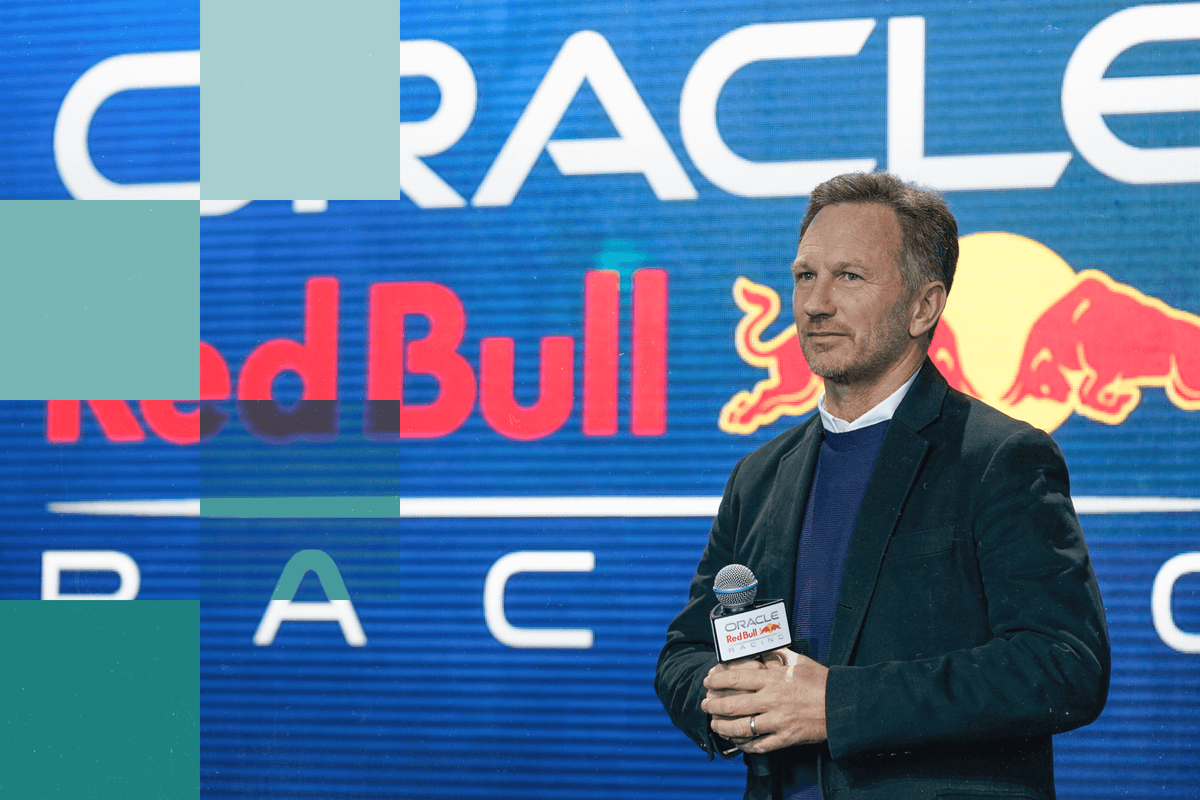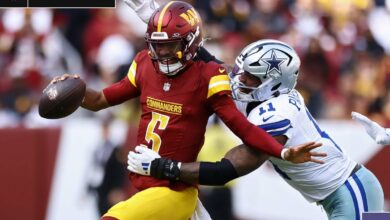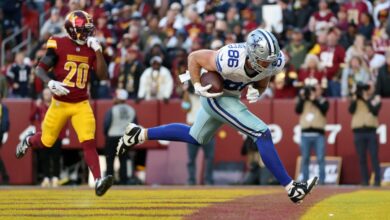The road to Ford’s F1 return with Red Bull: ‘I’m a big believer in fate’

This article is part of our Origin stories series, a look into the backstories of the clubs, drivers and people who drive the sport.
On the way to Brazil towards the end of the 2022 season, Red Bull Formula 1 boss Christian Horner stopped in the United States for a meeting that could decide the future of his team.
Months earlier, talks to enter into a partnership with Porsche had failed. Red Bull was keen to find a new manufacturer partner to support its internal engine programme, Red Bull Powertrains, which was formed after Honda left F1 at the end of 2021.
Horner was sitting in an office at Ford Motor Company’s headquarters in Dearborn, Michigan, for an important meeting. Talks about an F1 project began with Ford’s motorsport boss Mark Rushbrook and appeared to be going well.
But this meeting also included Bill Ford, the company’s chairman and great-grandson of its legendary founder, Henry Ford, and Jim Farley, its president and CEO. The stakes were so much higher.
Horner’s positive feeling was quickly confirmed. “I thought we were in good shape when Jim came into the meeting wearing a Sergio Pérez cap,” he recalled in July this year. “(I thought) ‘Okay, we look pretty good here!'”
It paved the way for Red Bull and Ford to agree a partnership that will start in 2026 when F1’s new engine rules are introduced. The collaboration will return the American car giant to the F1 grid after more than twenty years. Ford’s most recent involvement ended in 2004 when it sold its Jaguar team to Red Bull.
Although 2026 is only a few years away, the Red Bull Ford partnership is already working at speed, aware of the importance of the new regulations and the scale of the project.
“Together with Ford, we must succeed,” Horner said. “We cannot afford for this project not to succeed.”

The successful partnership between Red Bull and Honda will end after the 2025 season. (Mark Thompson / Getty Images)
Controlling his destiny
In October 2020, just 18 months after its first race as Red Bull’s engine partner, Honda announced it would leave F1 at the end of the 2021 season.
The shock decision, made to cut costs and move to electrification – and ultimately reversed three years later when it signed a deal with Aston Martin in 2026 – left Red Bull at a crossroads. Trying to buy engines from its main F1 rivals Ferrari or Mercedes would be difficult. Returning to previous partner Renault was not a feasible option. Renault’s underperformance since 2014 led to very public frustration at Red Bull.
So why not do it alone? Red Bull began investigating what it would take to create its own F1 engine. It would be a significant investment, but one that would put Red Bull in control of its destiny rather than relying on a partner who, as Honda proved, could exit F1 at any moment.
“Ultimately we decided that if we’re going to do it, we might as well do the whole thing,” Horner said.
Although Red Bull was successful as an F1 team, it did not have the technical might or existing knowledge base of its rivals as a power unit manufacturer. Horner said it quickly became clear that it was strategically better to partner with a car manufacturer. “Because as an independent manufacturer you miss the advantages that a Ferrari or a Mercedes or a Honda – which has changed their mind – technically have.”
Porsche seemed to become Red Bull’s favorite F1 partner. The Volkswagen Group wanted to get the brand back into F1 by 2026, to cement its rich motorsport heritage, which includes dominating F1 with McLaren in the mid-1980s. The talks neared a successful conclusion in the summer of 2022, but negotiations ultimately broke down. Porsche had sought an ownership stake, which Horner said Red Bull concluded was “not the right route for the company.”
It left Red Bull back at square one, looking for a manufacturer partner. Then Horner, who said he was “a big believer in fate,” received an email from Rushbrook that changed everything. Ford wanted to come back to F1. Would Red Bull be interested in a conversation?
“It happened very, very quickly,” Horner said.

Ford CEO Jim Farley, Ford’s Mark Rushbrook and Max Verstappen talk in the garage ahead of the 2023 Miami GP. (Mark Thompson/Getty Images)
Right place, right time
F1’s appeal to manufacturers has increased significantly for 2026. The proposed regulations for power units were more closely aligned with global automotive trends through a greater focus on electrification and fully sustainable fuels. At the same time, the off-track boom in popularity made its marketing appeal greater than ever.
Mercedes and Ferrari were already on the grid. Honda planned to return with Aston Martin. Audi had announced a 2026 entry. Now Ford also wanted to join the battle.
“When we saw what was happening in Formula 1 with the technical regulations, it was very aligned, giving us more opportunities to contribute and learn the innovation and technology transfer part of it,” said Rushbrook. “But certainly also the health of the sport, and its popularity worldwide and the diversity of the audience.”
Then it became a matter of How Ford would enter F1. It explored multiple options, including buying a team, as Audi did with Sauber, or developing a power unit division from scratch. Both would be very costly ventures, and Ford’s previous problems with owning Jaguar proved that running an F1 company had not been his forte. In five seasons the team scored just two podium finishes before being sold to Red Bull at the end of 2004.
Buying a team also didn’t fit with Ford’s broader motorsports model.
“Yes, we are involved in motorsport, but nowhere do we own or manage the team,” said Rushbrook. “We always work with partners, whether it is Dick Johnson Racing in Australia (Supercars), or Penske in NASCAR, or M-Sport in rallying.”
The timing worked perfectly to start discussions with Red Bull. When Rushbrook heard the Porsche deal was falling through, he managed to get Horner’s email address and sent an email mid-flight, getting the ball rolling and heading for a quick conclusion.
“We had been in discussions with Porsche for six months. It didn’t work,” Horner said. “I think it literally took 12 weeks from start to finish for the contract (with Ford) to be signed. From initial conversations with Mark, then with Jim Farley and Bill Ford, it was essentially decided in late ’22 that this was the way forward.”
The new partnership, announced in February 2023 to coincide with Red Bull’s seasonal launch, reaffirms Ford’s commitment to the next cycle of power unit regulations, from 2026 to 2030.
The deal works for both parties. Ford returns to F1 after 22 years with a championship-winning team that benefits from technology transfer – F1 serves as a high-speed laboratory for future road car innovations – and F1’s marketing power, without the liability of a team or a total engine program . It will also be the only American manufacturer on the F1 grid in a boom period for the sport in the United States.
And in Ford, Red Bull would gain a partner with the expertise and resources that can help its nascent engine program compete with the experience of Ferrari and Mercedes from the start.

Red Bull’s Christian Horner and Ford’s Jim Farley speak at the Red Bull 2023 season launch in New York. (Arturo Holmes/Getty Images for Oracle Red Bull Racing)
A partnership that is already in motion
The first Red Bull Ford powertrain won’t race in F1 for another eighteen months, but that won’t stop both parties from accelerating the collaboration.
The importance of the 2026 regulations revision, when the integration of the power unit into the car should have a huge impact on a team’s performance, means that this is already a priority for F1 manufacturers.
“Although ’26 seems far away, probably to the fans, you will have to make decisions about your racing engines in the coming months,” Horner said. “It’s literally tomorrow for the design teams.”
Red Bull Powertrains has grown rapidly as a result, with a significant recruitment drive, including a number of employees from competing F1 engine programmes, and the construction of two new buildings on the Milton Keynes campus, fully dedicated to the 2026 programme. The initial delivery of the Red Bull Ford engines will be for the two Red Bull teams, Red Bull and RB, but the facility has been built with the ability to supply a further two customer teams. Besides Ferrari, Red Bull is the only other team in F1 to have its team and engine at the same location.
Although there is no Ford logo on the Red Bull F1 car – the current engines are still Honda’s intellectual property and there is a technical agreement in place until the end of 2025 – their marketing efforts are already underway. Max Verstappen and Sergio Pérez have already taken part in demonstration events with Ford cars. Pérez drove the Ford Red Bull SuperVan, a fully electric van that produced the equivalent of more than 1,400 horsepower, up the famous Goodwood hill climb in July. Ford is also backing one of Red Bull’s entries into the all-female F1 Academy support series, and earlier this month named Chloe Chambers as its driver for 2025. Even the road cars used by Red Bull team members on race weekends are Fords.
The real success of the Red Bull-Ford partnership will become apparent in 2026, when an early engine advantage could be crucial. Mercedes proved that at the dawn of the V6 hybrid powerplant era in 2014, when it won a record eight seasons of constructors’ titles and dominated that era of F1.
Horner said he was under “no illusions” that Red Bull and Ford will face anything but a major challenge in 2026, pointing to the “decades of experience” that the likes of Mercedes and Ferrari have with their F1 engine projects.
“We have three years of experience,” Horner said. “But we have a tremendous amount of passion, we have some great people, we have great facilities, we have great partners and we have the attitude that has served us so well in the 120 race wins we have achieved to date.
“It will be hugely satisfying to supplement that number with an engine designed, built and manufactured right here in Milton Keynes.”

GO DEEPER
Lando Norris talks F1 title bid: pressure, mistakes and Max Verstappen’s friendship
(Top photo by Christian Horner: Seth Wenig / AP)




